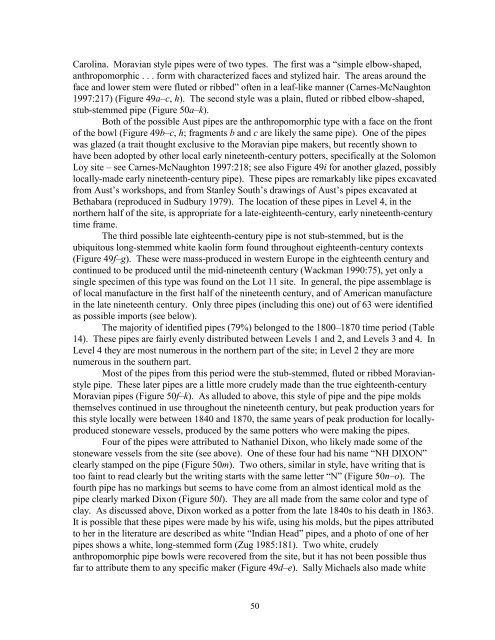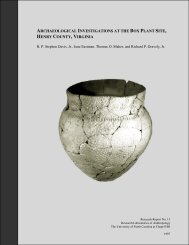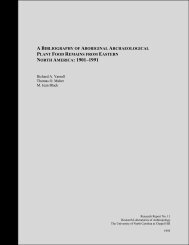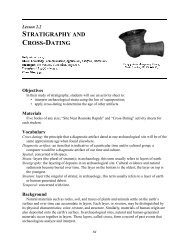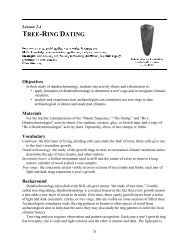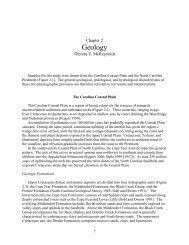Carolina. Moravian style pipes were <strong>of</strong> two types. The first was a “simple elbow-shaped,anthropomorphic . . . form with characterized faces and stylized hair. The areas around theface and lower stem were fluted or ribbed” <strong>of</strong>ten in a leaf-like manner (Carnes-McNaughton1997:217) (Figure 49a–c, h). The second style was a plain, fluted or ribbed elbow-shaped,stub-stemmed pipe (Figure 50a–k).Both <strong>of</strong> the possible Aust pipes are the anthropomorphic type with a face on the front<strong>of</strong> the bowl (Figure 49b–c, h; fragments b and c are likely the same pipe). One <strong>of</strong> the pipeswas glazed (a trait thought exclusive to the Moravian pipe makers, but recently shown tohave been adopted by other local early nineteenth-century potters, specifically at the SolomonLoy site – see Carnes-McNaughton 1997:218; see also Figure 49i for another glazed, possiblylocally-made early nineteenth-century pipe). These pipes are remarkably like pipes excavatedfrom Aust’s workshops, and from Stanley South’s drawings <strong>of</strong> Aust’s pipes excavated atBethabara (reproduced in Sudbury 1979). The location <strong>of</strong> these pipes in Level 4, in thenorthern half <strong>of</strong> the site, is appropriate for a late-eighteenth-century, early nineteenth-centurytime frame.The third possible late eighteenth-century pipe is not stub-stemmed, but is theubiquitous long-stemmed white kaolin form found throughout eighteenth-century contexts(Figure 49f–g). These were mass-produced in western Europe in the eighteenth century andcontinued to be produced until the mid-nineteenth century (Wackman 1990:75), yet only asingle specimen <strong>of</strong> this type was found on the Lot 11 site. In general, the pipe assemblage is<strong>of</strong> local manufacture in the first half <strong>of</strong> the nineteenth century, and <strong>of</strong> American manufacturein the late nineteenth century. Only three pipes (including this one) out <strong>of</strong> 63 were identifiedas possible imports (see below).The majority <strong>of</strong> identified pipes (79%) belonged to the 1800–1870 time period (Table14). These pipes are fairly evenly distributed between Levels 1 and 2, and Levels 3 and 4. InLevel 4 they are most numerous in the northern part <strong>of</strong> the site; in Level 2 they are morenumerous in the southern part.Most <strong>of</strong> the pipes from this period were the stub-stemmed, fluted or ribbed Moravianstylepipe. These later pipes are a little more crudely made than the true eighteenth-centuryMoravian pipes (Figure 50f–k). As alluded to above, this style <strong>of</strong> pipe and the pipe moldsthemselves continued in use throughout the nineteenth century, but peak production years forthis style locally were between 1840 and 1870, the same years <strong>of</strong> peak production for locallyproducedstoneware vessels, produced by the same potters who were making the pipes.Four <strong>of</strong> the pipes were attributed to Nathaniel Dixon, who likely made some <strong>of</strong> thestoneware vessels from the site (see above). One <strong>of</strong> these four had his name “NH DIXON”clearly stamped on the pipe (Figure 50m). Two others, similar in style, have writing that istoo faint to read clearly but the writing starts with the same letter “N” (Figure 50n–o). Thefourth pipe has no markings but seems to have come from an almost identical mold as thepipe clearly marked Dixon (Figure 50l). They are all made from the same color and type <strong>of</strong>clay. As discussed above, Dixon worked as a potter from the late 1840s to his death in 1863.It is possible that these pipes were made by his wife, using his molds, but the pipes attributedto her in the literature are described as white “Indian Head” pipes, and a photo <strong>of</strong> one <strong>of</strong> herpipes shows a white, long-stemmed form (Zug 1985:181). Two white, crudelyanthropomorphic pipe bowls were recovered from the site, but it has not been possible thusfar to attribute them to any specific maker (Figure 49d–e). Sally Michaels also made white50
anthropomorphic pipes (Sudbury 1979:181). At any rate, the Dixon pipes are certainly noearlier than around 1850.Five <strong>of</strong> these Moravian-style pipes came from the same mold, and are possibly theproduct <strong>of</strong> Solomon Loy (Figure 50f–k). They seem identical to pipes excavated from theSolomon Loy site which was in operation near Snow Camp between 1839 and 1865 (almostthe exact era <strong>of</strong> the “Poor House”) (Carnes-McNaughton 1997:49, 52). Trading networkswere well-established between Snow Camp and Pittsboro in the 1840s (Carnes-McNaughton1997:83–84). Direct comparison <strong>of</strong> these pipes and the molds from the Loy site in the futuremay confirm or negate this attribution.After mid-century, pipes from farther afield appear in the assemblage. A popularstyle in the 1850s was the “Presidential” or “Campaign” pipe. This style was produced inconnection with political campaigns, and the human head effigy was supposed to representthe likes <strong>of</strong> Henry Clay, Millard Fillmore, and Frank Pierce, to name a few (Carnes 1983:81–82). In reality, the heads appear fairly generic. These pipes are molded in high relief andglazed. Two such pipes were recovered from the site (Figure 51a–b). Figure 51a is possiblya John Tabor pipe. The pipe matches one in the assemblage from his pottery in NewHampshire (reproduced in Sudbury 1979). It appears that John Taber made clay pipes inPamplin, Virginia in 1860 before moving to New Hampshire (Sudbury 1979:171). Figure51b is similar to a President Fillmore pipe (reproduced in Sudbury 1979).The last pipe attributed to this time period is the stem <strong>of</strong> a stub-stemmed meerschaumpipe that is marked with an embossed 39 encircled by raised dots. The style is identical to thestems <strong>of</strong> figural pipes from a 1868 Gambier catalogue (Figure 51c) (reproduced in Duco1986).Six pipes likely postdating 1870 were identified (14% <strong>of</strong> identified types). Themajority <strong>of</strong> these pipes were found in Level 2 in the southern part <strong>of</strong> the site (Table 14).Three <strong>of</strong> these red clay pipes may have come from Pamplin, Virginia (Figure 51h–j) (all thepipes attributed to North Carolina were white or light brown clays). Pamplin was the center<strong>of</strong> a cottage industry <strong>of</strong> pipe making from the 1740s (Hamilton and Hamilton 1972:4). In1879, a factory opened there which subsumed the cottage industry (Sudbury 1979:206–208).The peak years <strong>of</strong> production for the factory were 1879–1900.One <strong>of</strong> these specimens (Figure 51i) is a Diamond-Stamped elbow pipe, “one <strong>of</strong> themost popular styles <strong>of</strong> nineteenth-century American clay smoking pipes” (Rist 1983:49).Besides being decorative, the knurled design dissipated heat efficiently, providing a coolersmoke (Rist 1983:49). The specimen from the Pettigrew site is similar to the Pamplinproduct because, unlike the majority <strong>of</strong> other diamond-stamped pipes (see Rist 1983), it ismade from the characteristic red clay, and has diamond stamping on both the bowl and stem(reproduced in Hamilton and Hamilton 1972).The two red-clay, smooth-surfaced, cylindrical pipes (Figure 51h, j) are similar to theproduct <strong>of</strong> the Pamplin home industry overseen by the factory (see Hamilton and Hamilton1972).A “TD”-marked pipe is also one <strong>of</strong> the pipes dating to the late 1900s from the site(Figure 51f). “TD” pipes have a long history. It is a long-stemmed, heeled, white clay pipe.The initials are attributed to Thomas Dormer, a pipemaker in England in the middle <strong>of</strong> theeighteenth century. Later, the term “TD” came to stand not for the specific maker, but for ageneric style <strong>of</strong> pipe (Walker 1983). Although “TD” pipes have been made continuously51
- Page 1 and 2:
ARCHAEOLOGICAL INVESTIGATIONS AT TH
- Page 3 and 4:
ABSTRACTArchaeological investigatio
- Page 5 and 6:
Moffitt, Brooks Rainey, Patricia Sa
- Page 7 and 8:
ChapterPage6. Conclusions and Recom
- Page 9 and 10:
TablePage16. Distribution of cerami
- Page 11 and 12: FigurePage18. Excavating Sq. 140R95
- Page 13 and 14: Chapter 1INTRODUCTIONThis report de
- Page 15 and 16: Chapter 2HISTORICAL BACKGROUNDThe t
- Page 17 and 18: Book 17:59-60). Gavin Hogg paid off
- Page 19 and 20: and the sale of the western half of
- Page 21 and 22: After the Civil War, the town fell
- Page 23 and 24: train young men and women to teach
- Page 25 and 26: the university was the Delta Kappa
- Page 27 and 28: ENDNOTES1 A typescript of this deed
- Page 29 and 30: Chapter 3FIELD METHODSFieldwork was
- Page 31 and 32: Chapter 4RESULTS OF ARCHAEOLOGICAL
- Page 33 and 34: foundations were 2 ft wide and the
- Page 35 and 36: Level 2aThis soil level occurred on
- Page 37 and 38: Feature 2Feature 2 was a linear dis
- Page 39 and 40: Feature 12Feature 12 was a small, s
- Page 41 and 42: ARCHITECTURAL GROUPA large number o
- Page 43 and 44: southern and northern parts of the
- Page 45 and 46: Kitchen GroupCeramics. As shown in
- Page 47 and 48: is probably no earlier than the sec
- Page 49: consumption of wine in ante-bellum
- Page 53 and 54: 50% of the assemblage). If, and whe
- Page 55 and 56: sat down. Diners then helped themse
- Page 57 and 58: ecords show his property increased
- Page 59 and 60: The ceramic marbles could easily be
- Page 61: southern to northern halves of the
- Page 65 and 66: TOILETRIES GROUPThe Toiletries grou
- Page 67 and 68: shampoo bottles, and a cosmetic jar
- Page 69 and 70: Items likely associated with the fr
- Page 71 and 72: Chapter 6CONCLUSIONS AND RECOMMENDA
- Page 73 and 74: REFERENCESAnonymousc.1797 Plan of t
- Page 75 and 76: Majewski, Teresita, and Michael J.
- Page 77 and 78: Wilson, Louis R.1957 The University
- Page 79 and 80: Table 1 continued.Activity Group Qu
- Page 81 and 82: Table 3 continued.Category 0-2 cm 2
- Page 83 and 84: Table 7. Distribution of kitchen ce
- Page 85 and 86: Table 10. Distribution of ceramic t
- Page 87 and 88: Table 13. Distribution of glass and
- Page 89 and 90: Table 17. Distribution of pharmaceu
- Page 91 and 92: PRESBYTERIANCHURCHHENDERSON STREETN
- Page 93 and 94: Figure 4. 1797 map of Chapel Hill a
- Page 95 and 96: Figure 6. 1857 Chapel Hill Business
- Page 97 and 98: Figure 8. View of Franklin Street l
- Page 99 and 100: Figure 10. Portion of a 1911 map co
- Page 101 and 102: Figure 12. Delta Kappa Epsilon hous
- Page 103 and 104: Figure 14. Kemp P. Battle with Phi
- Page 105 and 106: Figure 16. Portion of a 1932 map co
- Page 107 and 108: Figure 18. Excavating Sq. 140R95 pr
- Page 109 and 110: Figure 20. Removing topsoil from th
- Page 111 and 112: Figure 22. Exposing the south wall
- Page 113 and 114:
Pettigrew Site(RLA-Or412)Architectu
- Page 115 and 116:
Stone FoundationsStone FoundationsD
- Page 117 and 118:
Figure 28. View of Structure 2 full
- Page 119 and 120:
160 150 140 130 120 110 100100 ft99
- Page 121 and 122:
Figure 32. Prehistoric lithic artif
- Page 123 and 124:
Figure 34. Miscellaneous ceramic an
- Page 125 and 126:
Figure 36. Glassware: oil lamp chim
- Page 127 and 128:
Figure 38. Stoneware: Virginia-made
- Page 129 and 130:
Figure 40. Refined, undecorated war
- Page 131 and 132:
Figure 42. Whiteware plate, 9.5”
- Page 133 and 134:
Figure 44. Transfer printed wares:
- Page 135 and 136:
Figure 46. Transfer printed wares:
- Page 137 and 138:
Figure 48. Toothbrushes and possibl
- Page 139 and 140:
Figure 50. Early to mid-nineteenth-
- Page 141 and 142:
Figure 52. Refined, undecorated whi
- Page 143 and 144:
Figure 54. Glass cosmetic and shamp
- Page 145 and 146:
Appendix 1. Chain of title for Lot
- Page 147 and 148:
30030024060300Lot 11George Johnston


